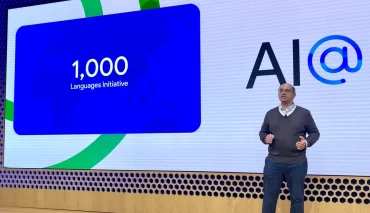
As more organizations race to showcase AI capabilities, it’s easy to feel pressure to move fast. But AI readiness isn’t about speed. It’s about building a foundation that lasts.
It’s easy to feel like you’re already behind on generative AI, especially if your only reference point is the ambitious deployments from big tech. In reality, the broader business landscape tells a more nuanced story.
While 71% of organizations recently reported regular use of Gen AI in at least one business function, another study found that 40% of enterprise-scale companies are experimenting with Gen AI usage in a broader business context, but have not yet taken their solutions to production.
As public awareness and promotion of generative and agentic AI intensifies, so does the urgency to act. But speed without strategy is risky. Too often, organizations rush from pilot to rollout without ensuring their data is complete or their teams are prepared to support AI at scale—resulting in tools that fail to solve real problems, strategies that stall out, and low user adoption driven by issues like hallucinations.
The real race isn’t to be the first to adopt AI. It’s about preparation and readiness, which goes beyond plugging in new tools. It means preparing your people to work with AI, ensuring your data can support it, and establishing the governance and operational frameworks to scale it responsibly.
Successful leaders in this space won’t be the first to deploy AI. They’ll be the ones who move with purpose and build the foundation to turn AI into real business value.
Mistaking “data in place” for “data that’s ready”
Trustworthy AI starts with trustworthy data. Yet, while 75% of executives say high-quality data is the most valuable ingredient for enhancing Gen AI capabilities, many organizations are struggling to meet that bar. Nearly half of CXOs (48%) admit their organizations lack the high-quality data needed to operationalize GenAI efforts.
The issue often stems from data immaturity. When internal data is siloed, lacks clear definitions, or is missing the context required for meaningful outputs, it undermines the foundation AI models rely on.
Data governance is another common friction point for responsible AI deployment. Without clear, consistent rules around access, data classification, and usage, organizations risk exposing sensitive data—whether through direct misuse or by failing to establish controls for using these systems effectively.
As AI becomes embedded in more everyday workflows—from customer service to internal reporting—those risks rise unless strong governance is in place. Real-time decisions made on flawed or improperly sourced data can compromise brand trust, security, and compliance.
Third-party data adds another layer of complexity. While external datasets can enrich AI performance, they must be credible, current, and appropriately structured. Without proper vetting, they can introduce bias or decisions that jeopardize the reliability of outputs.
When poor-quality data powers your AI systems, the consequences are immediate and make it difficult to build trust. In time-sensitive scenarios, like resolving a customer issue, there’s little opportunity to verify accuracy. And without strong access controls and governance, you expose your organization to unnecessary risk and customer satisfaction issues.
Here are some important steps to build a strong data foundation for AI.
- Conduct a full assessment of data sources to evaluate maturity and usability.
- Categorize data by sensitivity: what’s public, what’s confidential, and what’s regulated.
- Establish a clear access and security paradigm that defines who can access which data sets.
- Align access levels with business roles and data sensitivity.
- Vet the quality and structure of external data inputs before integrating them into models.
Getting your data in order is only the beginning. Turn readiness into results with a structured, phased approach to AI experimentation and adoption.
See also: AI Adoption Races Ahead Without Data Readiness
A roadmap for responsible AI adoption
Organizations often rush from early experimentation to broad deployment without a clear roadmap in between. The result? Fragmented adoption, limited impact, and employee skepticism about whether they can rely on AI tools in their day-to-day work.
True AI readiness means aligning tools with real business problems and the people who will use them. By treating adoption as a phased journey, not a one-time launch, organizations can create a lifecycle that validates the investment—and earns buy-in—at every stage.
Phase 1: Experimentation. With AI tools evolving rapidly, you need space to test features and assess potential fit for your specific business needs. During this phase, focus on understanding each tool’s functionality and how it could align with your intended use cases.
But experimentation requires guardrails. Limit testing to public or synthetic data, and avoid using systems containing intellectual property, customer information, or other regulated data. This approach allows flexibility to explore solutions while keeping risk in check.
Phase 2: Proof of concept and value. Once a tool shows promise, you can shift from exploration to evaluation. Start by testing whether it can technically address your targeted business challenges—that’s your proof of concept.
Proof of value goes a step further. By piloting the tool with your data in a controlled environment, you can assess the real-world impact. Can it reduce resolution times, improve accuracy, or streamline workflows?
Success hinges on clearly defined metrics and rigorous evaluation. Even with tools that are widely trusted in the industry, validation within your own context is essential.
Phase 3: Rollout and continuous tuning. Proving business value is only part of the equation. Rollout is where strategy meets culture—and often where friction surfaces. Employees may question the accuracy of AI outputs, resist changes to their workflows, or simply not understand when or how to use new tools.
These hurdles are natural, but you can overcome them with clear, top-down communication. Beyond offering support and training on how to effectively use AI tools, you have to communicate your AI strategy from the top to ensure employees understand the strategic purpose behind new AI use cases and tools.
Effective change management also requires listening: gathering feedback from different departments, adjusting strategy, and iterating as needed.
See also: Closing the AI Readiness Gap: Unlocking the Full Potential of AI Agents
Lasting impact starts with AI readiness
As more organizations race to showcase AI capabilities, it’s easy to feel pressure to move fast. But readiness isn’t about speed. It’s about building a foundation that lasts.
That means grounding every AI initiative in a business outcome, laying the data groundwork to support it, and preparing your teams to embrace and trust AI-generated outputs. When you approach AI as a lifecycle that connects strategy, data, and people, you’re better positioned to scale with confidence and deliver lasting impact.































